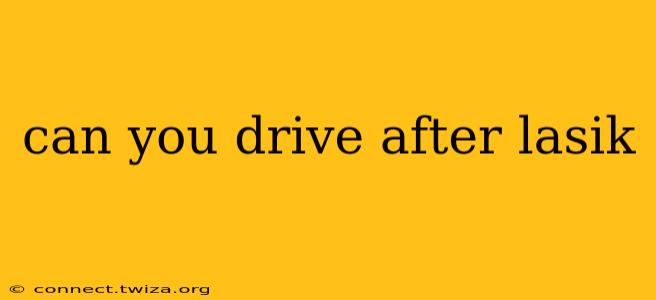LASIK surgery is a revolutionary procedure that corrects refractive errors in the eyes, improving vision and reducing reliance on glasses or contact lenses. Many people wonder about the immediate aftermath, especially regarding driving. The simple answer is: it depends. While some individuals can drive home after LASIK, it's crucial to understand the potential risks and follow your ophthalmologist's advice. This comprehensive guide will explore the factors influencing driving ability post-LASIK.
How Soon Can I Drive After LASIK?
This is the most frequently asked question. There's no single answer applicable to everyone. The timeframe depends on several factors, including:
- Individual response to the surgery: Some patients experience minimal discomfort and visual recovery, while others may have more pronounced side effects.
- Type of LASIK performed: Different LASIK techniques may influence the recovery process and visual acuity.
- Pre-existing eye conditions: Pre-existing conditions could impact recovery time.
- Ophthalmologist's recommendations: Your surgeon is the best source of personalized advice.
Generally, you should not drive immediately after LASIK. The immediate post-operative period often involves blurred vision, sensitivity to light (photophobia), and potential dryness. These symptoms can significantly impair your ability to drive safely.
What Are the Potential Risks of Driving After LASIK?
Driving with impaired vision after LASIK presents several significant risks:
- Reduced visual acuity: Blurred vision, halos, or glare can make it difficult to judge distances and react to changing traffic conditions.
- Sensitivity to light: Photophobia can make driving in bright sunlight or at night extremely challenging.
- Dry eyes: Dry eyes can cause discomfort and blurry vision, hindering safe driving.
- Difficulty focusing: Temporary difficulty shifting focus between near and far objects can make driving dangerous.
- Unforeseen complications: While rare, unexpected complications after LASIK could further affect vision and driving ability.
What Should I Do After LASIK Surgery Before Driving?
Prioritize safety. Follow your surgeon's post-operative instructions meticulously. This typically involves:
- Arranging for transportation: Have a friend, family member, or taxi service take you home from the surgery center.
- Resting: Allow sufficient time for your eyes to rest and begin recovering.
- Using eye drops: Use prescribed eye drops as directed to maintain eye lubrication and promote healing.
- Avoiding strenuous activities: Refrain from activities that might strain your eyes or increase intraocular pressure.
- Following up with your doctor: Attend all scheduled post-operative appointments.
When Can I Resume Driving After LASIK?
You should only drive when:
- Your ophthalmologist clears you: This is the most critical factor. They will assess your vision and recovery progress before giving the go-ahead.
- Your vision is clear enough for safe driving: You should be able to see clearly at all distances, including street signs and other vehicles.
- You are comfortable driving: You should feel confident and in control behind the wheel.
What if I Experience Complications After LASIK?
If you experience any unexpected problems—severe pain, significant vision changes, or excessive bleeding—contact your ophthalmologist immediately. Do not attempt to drive yourself; seek help.
How Long Does It Take for Vision to Fully Recover After LASIK?
Full visual recovery after LASIK can vary, typically taking several weeks to months. During this time, you may experience fluctuating vision and some residual side effects. Consistent follow-up appointments with your ophthalmologist are crucial to monitor your progress and address any concerns.
Remember, prioritizing safety is paramount. Do not rush the recovery process. Always follow your ophthalmologist's advice regarding when it is safe to resume driving. Your safety and the safety of others depend on it.
